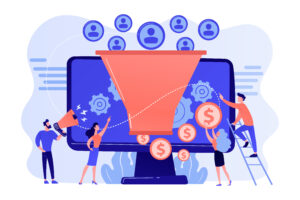Brad Post, Create the Movement, host
Dominick Montgomery, Create the Movement, guest
Brad Post, Create the Movement, host: Welcome back to Create the Movement Podcast. This is Brad Post and I’m sitting with our Chief Marketing Officer Dominick Montgomery. Dominick, how are you, man?
Dominick Montgomery, Create the Movement, guest: Doing well. How are you, Brad?
P: Good, good. A lot of times our podcast interviews other people and Dominick’s on the back-end working some amazing stuff. We head-locked him again today and got you involved in the podcast. Thanks for being with us, man.
DM: Yeah, absolutely. We’ve had to reschedule this like five times.
BP: Yeah! Just a few times. So much going on. Today we’re going be talking about email marketing. Correct?
DM: Yeah. Email marketing, email-marketing campaigns, content market – however you want to call it.
BP: Awesome. We’ve dove into this in the past few years of our business and come up with some different approaches. There’s different types of approaches, different types of sites as you mentioned, Dominick. You want to dive into that first?
-
The Differing Goals of Email-Marketing Campaigns
DM: Yeah, sure. When we start talking to clients about email marketing we have to first figure out their goals for the campaign. So, there’s different types of goals. There’s engagement goals: they want to engage with an audience more. There’s branding goals: they want to get their brand out. There’s promotional goals: they want people to purchase items that are on sale or on promo. Or, if they’re selling services they send out an email to their client, or to potential clients, and let them know about service deals. We do that at CTM.
First, figuring out the goals. Sometimes the goal is to drive traffic to a certain landing page which is always interesting because at CTM we’re really conversion driven, but when you’re dealing bigger brands or enterprise-level brands, sometimes all they need is more engagement. All they want is more traffic to a particular source on their site. And that might be a landing page that has an ebook on it or a value proposition. We’ve dealt with that. We use HubSpot for some of our ebooks that Brad wrote. Right?
BP: That’s right. I think we’ve got seven different landing pages on different ebooks.
DM: Yeah. Brad cranked out seven ebooks – amazing.
BP: That was fun.
DM: An email-marketing campaign for something like that, let’s we are promoting a new book. CTM wrote a new book; we want to promote it. Obviously, the email campaign has a goal of getting people to the page to then download the book. And there’s a lot of things that have to happen in tandem with that.
Post downloading the book, you have to think: Do you want to just give them the book there on the site? Do you want to then send them an email that has a link to the book which furthers the email marketing? And then after they download the book from that email, do you want to continue engaging with them week-to-week by sending emails with other ebooks or emails with related topics?
So that’s the email marketing approach when it comes to an already established company that’s got traffic coming to the site and customers come there all the time to look up new stuff.
-
Best Practices
DM: Now, if you’re dealing with email-marketing agency site, and you’re doing outreach to get clients – that’s a whole ‘nother ball game. And we’ve run into that. There are a lot of email-specific laws and guidelines to follow when you’re sending emails out.
BP: Best practices or whatnot.
DM: Best practices. There’re anti-spam laws. For those who don’t know, to email people, it’s good practice to get the person who you’re email get them to ‘opt-in’ to something so then you have permission to email them. ‘Sign Up For Our Newsletter’ and they put in their email address, and now you have permission to email them.
Now, you’re not going to get in a whole bunch of trouble if you’re emailing people without their permission as long as you’re not spamming them with five, six, seven emails a day I think you’re good to go. And as long as you have an ‘Unsubscribe’ button on the bottom of the email so that they can unsubscribe, and they’re off your list, and they won’t get your emails anymore.
-
Testing with Image-based and Text-based Emails
DM: Now, there’s a lot of testing that goes on if you’re agency-side. We’ve tested with text-based (text-only) emails where it looks like a friend is emailing you or a relative. We’ve experimented with image-driven emails that have a great layout, a good templated design, that’s got our custom artwork, custom graphics, looks beautiful, it’s very persuasive.
And then we’ve dabbled with an email with both. It’s mostly text, but we might have one image or throw a gif in there. Maybe we do an oversized button right in the middle of the text to influence somebody to click on it and sign up for a website audit or something like that.
What we’ve found is that in our niche text-based emails perform better than image-based. Which is interesting because if you follow it it takes four or five different types of test emails to even get to that point. So, if you’re agency-side and you’re reaching out to people who are more artsy or more on the creative side, then you might do better with an image-based email campaign.
I would never suggest just doing text only and sending it and saying, “Oh, email marketing doesn’t work for me.” It’s all about testing. Wouldn’t you agree?
BP: I totally agree. I was going to say the text-only, it looks like it’s more someone specifically writing you an email and a lot of times on the image-driven you can almost tell that it’s pretty sales-y or it’s more of trying to upsell or sell them on something. Sometimes the text more like, “Hey, who’s this emailing me?”
-
Content
DM: Right. Exactly. We could dive into specifics – I’m not going to. Everything matters when you’re writing copy for email. There’re people who run entire companies off of just writing email copy. Everything matters from the subject line, to the greeting, to the length of the copy, to the signature and the sign-off – all of that matters.
I say that to just reiterate the fact that testing is imperative when it comes to email marketing. You have to test. You can’t just send out a blast to a 100 people and see that you only got a 1% open rate and say, “I’m done.” Tweak that email – try it again. Tweak it more – try it again. If you continue tweaking you’re going to find that sweet spot, for sure. Because I think everyone can benefit from email marketing.
Now, that’s the smaller niche campaign. On wide-scale enterprise campaigns – those are different. Because they have whole teams of email. They have an email-marketing outreach team and all they do is test and they have a huge customer base and they’re only sending their emails to their customers. That’s different. We don’t really deal with that. I’m talking about the eBay’s of the world. You bought something on their site, now they’re going to send you an email every day that has products that are similar to what you bought.
Which is crazy to me because if I already bought a product, I don’t want another one that’s similar. If it were me I would have them selling related products or just following up and saying, “Hey, how are you liking the product? Why don’t you come back and review it?” Instead of just continuously pushing product.
-
Email Marketing for E-commerce
DM: And that moves me to my point: email marketing for e-commerce. E-commerce is a crazy world and the competition is always high. You’ve got people putting up Shopify sites that have same products everyday. You’ve got one guy who’s selling hunting gear and he’s competing with 4000 other people everyday for the same product. That’s crazy. And that’s crazy hard to show up well for those products in search engines and even with pay-per-click. So, email marketing could be very, very beneficial for e-commerce sites and e-commerce businesses.
The first thing for ecommerce that you need to figure out is who your demographic is and you have to meet them where they’re at. If you’re selling hunting gear, for example, you should be in those hunting-gear forums, you should be in those hunting forums, you should be in those hunting Facebook pages. You should be a part of the community. You should go on Reddit and join a hunting subReddit. You should always be there, not necessarily offering products, but just offering either sound advice or sound content that will then get them to your site and hopefully they’ll ‘opt-in’ because they like what you’re talking about. Does that make sense?
BP: Absolutely. Opting in by downloading one of your books, or asking for the newsletter or something like that.
DM: Absolutely. “If you want to stay up to date with all of our blogs: sign up. We’ll send you email” Then, as you’re growing your ecommerce website and you’re growing content you’re going to start writing different types of content in different categories. So, then you can see what people are reading what type of content and based on that you know what type of product you need to pitch to them via email. So, there’s this whole web of figuring out who you’re actually send what to when it comes to e-commerce.
I think that’s important because nothing’s worse than getting pitched product that you will never buy and has nothing to do with you. And I’m sure if you went to your ‘Spam’ folder right now you’re going to see a whole bunch of products that you would never buy. Either you’re not interested in the type of product, or it’s just out of your price range and why would somebody ever offer you something that pricey? Or, you’ve already bought that thing from that company. Why are they sending it to you again?
With email marketing there’s a flow – a beginning phase which is figuring out who you’re sending to, figuring out copy, and figuring out your tests. And the middle phase – they’ve engaged with you now, so let’s figure out what type content we need to send them now, now that they’ve engaged. Now that they’ve either downloaded a book, or they’ve bought a product from us. And then there’s the end phase which we call the post-nurturing phase where now we want to keep them engaged, but we don’t to overwhelm them with emails, we don’t want to overwhelm them with products. But we do want to make ourselves the go-to company in that niche. So we want to send them an email maybe once a month that has to do with the content that we know that they liked, or has to do with new products that we have that maybe be accessory to the product that they bought before.
BP: That’s great, man.
DM: Thanks. So we don’t dive too far into it, I think that’s a broad overview of email marketing. I think if anybody wants to hear more about any of those, whether it be e-commerce agency-side or wide-scale email marketing let us know and we’ll dive in deeper.
BP: Absolutely. Awesome Dominick. Thanks for your time today.
DM: Absolutely. Thanks for getting me in a head-lock.
BP: Look forward to next time.
DM: Okay, man.











